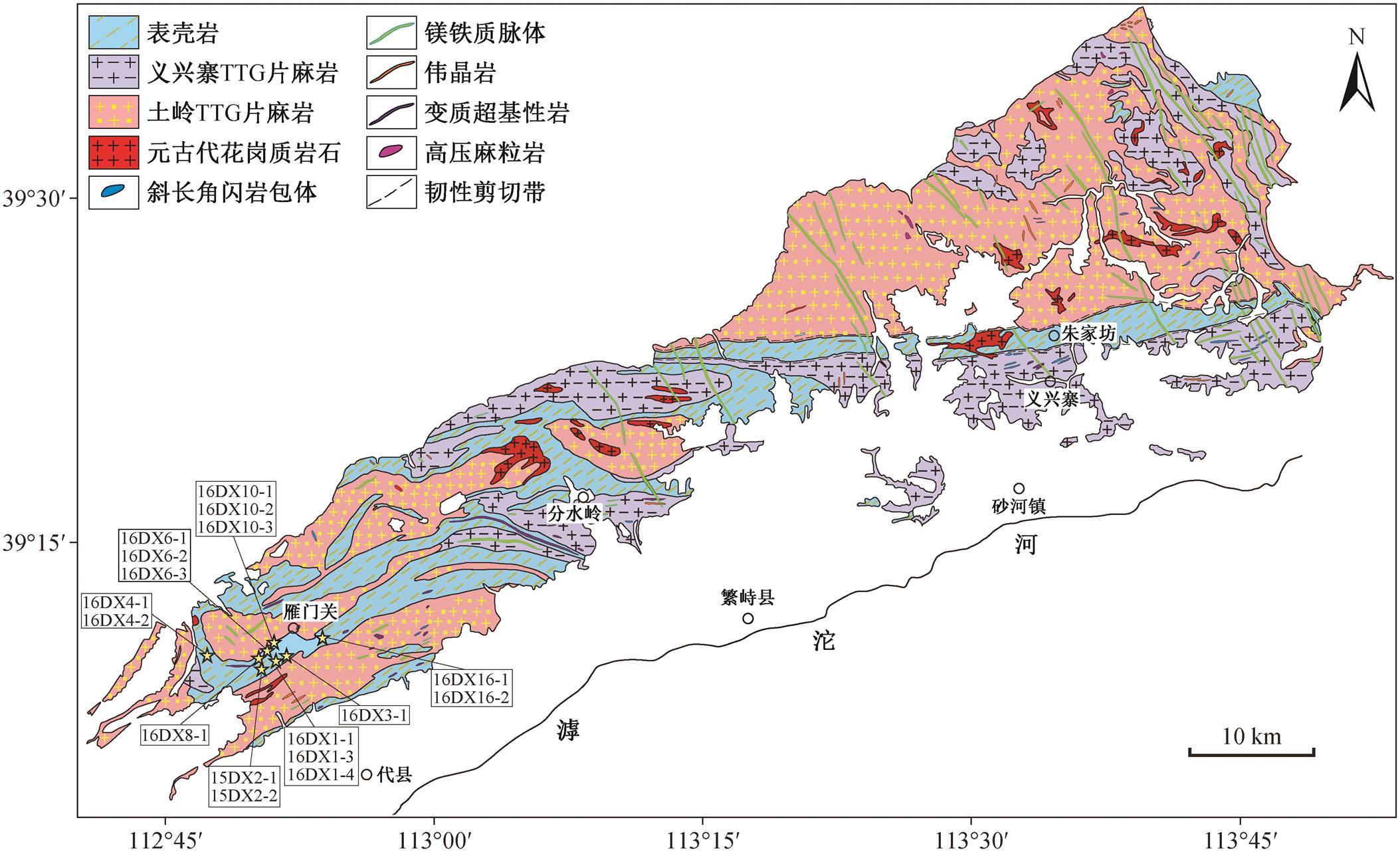
图1 恒山地区地质图和采样位置
Fig. 1 Geological map of Hengshan area and sample locations
北京大学学报(自然科学版) 第59卷 第1期 2023年1月
Acta Scientiarum Naturalium Universitatis Pekinensis, Vol. 59, No. 1 (Jan. 2023)
doi: 10.13209/j.0479-8023.2022.102
国家自然科学基金(42172215, 41530207)资助
收稿日期: 2022-03-07;
修回日期: 2022-04-25
摘要 对恒山地区出露的变质火山岩开展岩相学、地球化学、锆石 U-Pb 年代学和 Hf 同位素研究, 旨在确定其形成时代, 探讨岩石成因及地球动力学意义。锆石 U-Pb 定年结果表明, 这些变质火山岩喷发于新太古代晚期(2508±20Ma)。地球化学分析结果显示, 恒山变质火山岩由变质玄武岩和变质玄武安山岩组成, SiO2 (45.51%~62.67%)、FeOT (4.43%~15.72%)和 MgO (3.75%~8.14%)含量变化幅度大, 是幔源岩浆经单斜辉石、角闪石和磁铁矿分离结晶的产物。这些变质火山岩富集轻稀土(LREE)和大离子亲石元素(LILE), 亏损重稀土(HREE)和高场强元素(HFSE), 具有相对高的 Th 含量和 Th/Yb 比值, 呈现钙碱性岛弧火山岩的特征。结合不相容元素比值 Nb/Yb, Zr/Yb 和(Nb/La)N的特点, 推测其来源于俯冲带具流体交代特征的富集地幔源区。结合区域构造背景, 推断恒山变质火山岩形成于新太古晚期大陆弧环境。
关键词 恒山地区; 新太古代晚期; 变质火山岩; 地球化学; 大陆弧
地球早期演化过程中的地球动力学体制是早前寒武地质学研究的关键问题[1‒4]。研究表明, 这一地球动力学体制可能是从以滞留–盖层、地幔柱和重力沉降等为主的垂向构造逐渐演变为以板块俯冲为主的水平构造[5‒10]。近年来, 越来越多的证据显示, 新太古代晚期‒古元古代界限附近(2.5Ga)是地球演化历史中的一个关键时期, 并且该时期存在建立现代板块构造体制的趋势[7,11]。作为太古宙‒古元古代克拉通内的主要组成部分, 花岗‒绿岩带记录着这一关键时期地球形成和演化的重要信息[12], 因此华北克拉通内出露的 2.6~2.5Ga 新太古代晚期花岗‒绿岩带成为探究这一关键转变时期壳幔动力学过程的重要窗口。
五台‒恒山‒阜平地区出露华北克拉通典型的花岗‒绿岩带, 主要由变质程度较高的恒山‒阜平高级区(主要出露变质深成岩和高压麻粒岩)和变质程度较低的五台低级区(花岗‒绿岩带)组成[13]。新太古代‒古元古代时期, 五台‒恒山‒阜平地区经历了几乎相同的演化过程, 都发育大量与岛弧岩浆作用相关的花岗质岩石[14‒18], 新太古代末‒古元古代早期存在板片俯冲的动力学体制[10,13,17,19‒26]。
对这一板片俯冲体制的认识, 除依据区域内发育的花岗质岩石外, 前人的研究集中在五台绿岩带中变质火山岩[20,24,27‒30]和变质沉积岩[31‒33]的地球化学以及五台‒恒山‒阜平地区的变形变质方面[34‒42]。尽管目前普遍认为该区域的构造体制形成于新太古代‒古元古代早期的岛弧背景[13,17,20‒28,32‒33,38,43‒45], 但对于究竟是陆弧[13‒15]还是洋弧[17,20,28,33,45‒46], 仍然存在争议。
Sun 等[21]近期对五台‒恒山‒阜平地区新太古代至古元古代中酸性岩浆岩中锆石的 Hf 同位素研究结果显示, 该区域在 2.52Ga 之前呈现洋弧的特点, 2.52Ga 之后则表现出陆弧的特征。在恒山高级变质区不仅发育 TTG (英云闪长‒奥长花岗岩‒花岗闪长质)片麻岩、高压麻粒岩和斜长角闪岩, 还保留少量变质火山岩。然而, 有关变质火山岩的研究, 迄今仅限于变质作用的 P-T-t 轨迹和变质作用的时代[35,47], 缺乏变质火山岩的原岩时代和构造背景的相关研究, 严重地制约对五台‒恒山‒阜平地区新太古代末‒古元古代早期构造演化的全面理解。
基于上述背景, 我们对发育于恒山高级变质区的变质火山岩开展岩相学、锆石 U-Pb 年代学和地球化学研究, 试图限定其原岩时代及构造环境, 不仅为该地区新太古代‒古元古代的构造演化提供直接的证据, 而且为全面理解华北克拉通新太古代末‒古元古代早期构造体制提供重要的制约。
华北克拉通是世界上最古老的克拉通之一, 由太古宙‒古元古代的变质基底和中元古代‒新生代的盖层序列组成[48], 保存着最老年龄约为 3.8Ga 的岩石记录[49]。华北克拉通的结晶基底主要由太古宙晚期(约 2.6~2.5Ga)的 TTG 片麻岩和变质火山‒沉积序列(花岗‒绿岩带)组成[3,50‒53]。因太古宙至古元古代经历了复杂的构造演化和多阶段的地壳生长事件[3,54‒58], 华北克拉通成为全球早前寒武研究的热点地区之一。
尽管对华北克拉通前寒武纪基底的微陆块数量以及碰撞、拼合的时间仍有争议[3‒4,23,47‒48,52‒53,59‒65], 但当前普遍将华北克拉通基底划分为东部陆块、西部陆块和中部带 3 个单元。其中, 西部陆块先由北部的阴山地块和南部的鄂尔多斯地块在约 2.1~1.9 Ga 时沿古元古代集宁‒千里山孔兹岩带俯冲、碰撞而成, 随后在约 1.85Ga 时沿着中部带与东部陆块碰撞、拼合, 形成完整的华北克拉通[53,57,66]。
如图 1 所示, 恒山地区位于华北克拉通中部带中段, 北至桑干河, 南部以滹沱河为界与五台花岗‒绿岩带相隔, 东南部以龙泉关剪切带为界与阜平高级变质区相接。该区主要由太古宙高级变质基底和呈岩片穿插其中的表壳岩组成[67], 可进一步划分为北恒山杂岩、南恒山杂岩以及将两者分隔的朱家坊韧性剪切带三部分, 具有十分重要的区域构造意义, 吸引了众多学者在此开展研究[14‒15,34‒35,38,42,47,68‒71]。
北恒山杂岩主要由英云闪长质、奥长花岗质和花岗闪长质等花岗质片麻岩、镁铁质脉体以及高压镁铁质麻粒岩组成, 其中花岗质片麻岩以年龄为约2.52~2.48Ga 的 TTG 片麻岩为主, 称为土岭 TTG 片麻岩, 还发育少量年龄为约 2.71~2.67Ga 花岗质片麻岩以及约 2.44~2.43 和 2.14~2.03Ga 的二长花岗质片麻岩(图 1)。这些岩石普遍遭受部分熔融和 1.88~ 1.85Ga 期间的高压麻粒岩相变质作用, 伴随多期变形[14‒15,17,19,47,72]。镁铁质脉体和高压镁铁质麻粒岩呈层状、布丁状和透镜状产于花岗质片麻岩中, 其中基性麻粒岩以峰期后等温降压的顺时针 P-T 轨迹为特征[47]。Kröner 等[69]认为这些镁铁质麻粒岩的原岩为约 1.92Ga 时形成的基性岩墙, 于 1.88~1.85 Ga 期间经历麻粒岩相变质作用, 也有学者认为部分镁铁质块体可能代表残存于混合岩中未发生部分熔融的难熔组分[38]。

图1 恒山地区地质图和采样位置
Fig. 1 Geological map of Hengshan area and sample locations
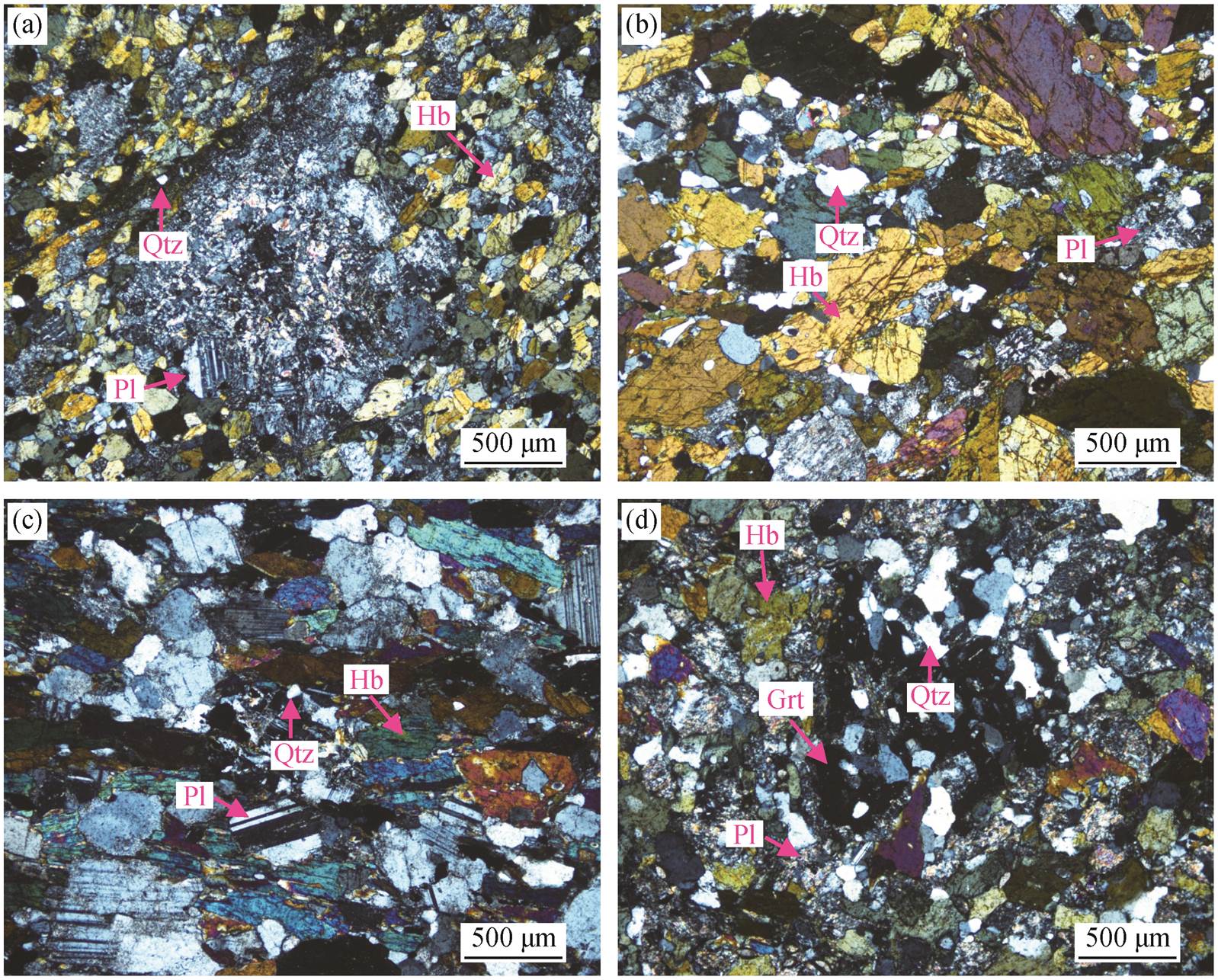
(a)含长石斑晶的斜长角闪岩; (b)斜长角闪岩, 粒状或柱状变晶结构, 块状构造, 角闪石颗粒较大; (c)角闪斜长片麻岩, 粒状或柱状变晶结构, 片麻状构造; (d)石榴石斜长角闪岩, 斑状变晶结构。Hb:角闪石; Qtz:石英; Pl:斜长石; Grt:石榴石
图2 具有代表性的变质火山岩显微镜下照片
Fig. 2 Photomicrographs of the representative metavolcanic rock samples from Hengshan area
南恒山杂岩不仅出露与北恒山杂岩相同的土岭TTG 片麻岩, 还出露义兴寨 TTG 片麻岩和残存在TTG 片麻岩中的表壳岩及基性岩墙(图 1)。义兴寨TTG 片麻岩以英云闪长岩为主, 变形程度比北恒山杂岩中的 TTG 片麻岩弱, 具有均一的片麻理, 含少量镁铁质包体[73]。锆石 U-Pb 定年结果显示, 义兴寨 TTG 片麻岩以及其中的镁铁质包体结晶年龄为2499~2502Ma[21]。残存于 TTG 片麻岩中的表壳岩主要为(石榴)斜长角闪岩、直闪石岩以及云母片岩等, 其原岩的形成时代约为 2.5Ga[15,73‒74]。在石榴斜长角闪岩中获得 1.92Ga 的变质年龄和顺时针的P-T 轨迹, 其变质峰期条件为约 1.1~1.3GPa, 650~ 800℃[35,75]。在义兴寨和雁门关地区, 还发育侵入TTG 片麻岩中的基性岩墙群。这些基性岩墙群经历了高角闪岩相到麻粒岩相的变质[75‒76], 其原岩结晶时代为 2035~2060Ma[77]。此外, Wang 等[78]在雁门关地区还识别出一期年龄约为 2.2Ga 的镁铁质‒超镁铁质侵入体。
朱家坊韧性剪切带位于南恒山杂岩与北恒山杂岩之间, 沿东西向展布, 宽约 2km, 将北恒山麻粒岩相和南恒山角闪岩‒麻粒岩相两套岩石单元分隔。朱家坊韧性剪切带主要发育表壳岩系, 主要岩石组合有变质砂岩、片岩、黑云斜长角闪片麻岩、(石榴)斜长角闪岩以及条带状铁建造(BIF)等。前人认为表壳岩系中的变质沉积岩以及斜长角闪岩为沉积‒火山成因, 可以与五台地区绿岩带中的五台群进行对比[67,79]。但是, Kröner 等[15]认为它们是强烈糜棱岩化的正片麻岩和基性岩墙。剪切带中岩石普遍发育角闪岩相变质, 矿物出现重结晶, 具有矿物拉伸线理和糜棱叶理, 区域中韧性剪切带的糜棱面理切割其两侧岩石的早期矿物组构[40,42]。Trap 等[38]对剪切带变泥质岩中独居石进行定年, 获得 1884±11Ma 的等时线年龄。He 等[34]对剪切带内的副片麻岩和花岗岩脉体进行定年, 获得 1938±31Ma 的变质年龄和 1860±16Ma 的花岗质脉体结晶年龄。对该区域构造的研究结果表明, 恒山地区共经历 5 期变形(D1~D5), 朱家坊剪切带(D4)为碰撞过程中下、中地壳相对移动, 发生右行剪切作用而成[40,42,67]。通过该次剪切变形作用, 北恒山早期变质的岩石沿着朱家坊剪切带折返上升, 进入浅部地壳。因此, 与北恒山杂岩相比, 南恒山杂岩经历的变质作用程度较低[34]。
恒山高级变质区除发育大量 TTG 片麻岩和麻粒岩外, 还出露变质火山岩。这些火山岩呈层状产出于表壳岩中, 或以包体(麻粒岩或斜长角闪岩)和顶垂体的形式残存在 TTG 片麻岩中。本研究在南恒山雁门关地区采集 17 块具有代表性的变质火山岩样品, 其中 7 块为呈层状产出的表壳岩, 10 块为TTG 片麻岩中的包体。这些变质火山岩样品经历了角闪岩相变质作用, 其岩性主要为斜长角闪岩、石榴石斜长角闪岩和角闪斜长片麻岩。显微镜下观察到斜长角闪岩发育粒状或柱状变晶结构和斑状变晶结构, 片麻状构造, 主要矿物为角闪石(65%~80%)和斜长石(15%~30%), 含少量石英和磁铁矿。其中, 细粒斜长角闪岩(图 2(a))为斑状变晶结构, 片麻状构造, 含绢云母化的长石斑晶, 主要矿物为角闪石(70%)、斜长石(25%)和石英(4%); 中粒斜长角闪岩(图 2(b))为粒状或柱状变晶结构, 块状构造, 主要矿物为角闪石(65%)、斜长石(30%)、石英(4%)和磁铁矿(1%); 角闪斜长片麻岩(图 2(c))为粒状或柱状变晶结构, 片麻状构造, 主要由斜长石(55%)、角闪石(40%)、磁铁矿(2%)和石英(2%)等矿物组成; 石榴石斜长角闪岩(图 2(d))为斑状变晶结构, 块状构造, 主要由斜长石(50%)、角闪石(40%)、石英(5%)和石榴石(4%)组成, 斜长石部分绢云母化, 石榴石变斑晶中含有石英和斜长石等细小包裹体, 呈筛状变晶 结构。
在野外采集新鲜的无脉体侵入的岩石样品。在显微镜下进行岩相学观察后, 将无石英细脉和碳酸盐脉的样品挑选出来用于全岩地球化学分析, 并选出用于锆石定年的样品。将挑选出的样品送到廊坊岩拓地质服务有限公司进行岩石粉碎和锆石单矿物分离及锆石制靶。制靶完成后, 利用显微镜对锆石靶进行反射光和透射光照相, 并在北京大学造山带与地壳演化教育部重点实验室使用 FEI QUANTA-650FEG 型扫描电子显微镜(SEM)进行锆石阴极发光(CL)图像拍摄, 结合锆石靶的反射光、透射光及CL 图像选取样品的测试点位。
火山岩全岩主量元素和微量元素分析在北京大学造山带与地壳演化教育部重点实验室完成。主量元素测定在波长散射扫描 X 射线荧光光谱仪(XRF)上进行, 工作条件为 50kV, 50mA。采用 GSR-2 (安山岩)、GSR-3 (玄武岩)和 GSR-15 (斜长角闪岩)等标样监测数据质量, 设置多个平行样来监控仪器的稳定性, 最终得到的分析精度在 0.5%以内[17]。经过化学溶解等前处理步骤之后, 在 Agilent 7500ce ICP-MS 电感耦合等离子体质谱仪上进行微量元素分析, 用标样 GSR-2 (安山岩)、GSR-3 (玄武岩)、GSR-11(流纹岩)和 GSR-15 (斜长角闪岩)以及平行样来监测仪器的稳定性, 分析精度优于 10%。样品的火山岩全岩主量元素和微量元素分析数据列于附录 1 (访问http://xbna.pku.edu.cn 查看附录)。
锆石样品的 U-Pb 和 Lu-Hf 同位素分析在北京大学造山带与地壳演化教育部重点实验室完成。在Agilent 7500ce 激光剥蚀电感耦合等离子质谱仪(LA-ICP-MS)上进行锆石 U-Pb 同位素分析, 束斑大小为 32 μm, 采用 91500 锆石作用外标进行校正, 同位素比值计算使用 GLITTER 4.0 软件, 普通铅校正使用 Anderson[80]的方法, 年龄计算及谐和图绘制采用 Isoplot 程序。在 Nu PlasmaⅡMC-ICP-MS 上进行锆石原位 Lu-Hf 同位素分析, 以国际标样 91500 锆石作为标样进行校正, 利用标准锆石 Plešovice 检验校正结果。样品的锆石 U-Pb 和 Lu-Hf 同位素分析数据分别列于附录 2 和 3。
4.1.1 元素活动性
太古宙岩石普遍经历的变质作用改造会显著地影响其中元素的活动性[81]。恒山火山岩变质程度较高, 因此需对样品的元素活动性进行判别, 选择相对不活动的元素来追溯原岩的组成及岩石成因。
Polat 等[82]提出利用样品的 Ce 异常(δCe)是否介于 0.9~1.1 之间以及烧失量(LOI)是否低于 6%来判别火山岩是否遭受严重蚀变。本研究样品的 δCe 介于 0.86~1.15 之间, LOI 介于 0.42%~1.56%之间, 表明样品未遭受严重的蚀变。恒山变质火山岩的蚀变指数 A.I.([(MgO+K2O)/(MgO+K2O+Na2O+CaO)×100])在 27.88~39.24 之间, 过铝质指数 P.I. (Al2O3/(CaO+ Na2O+K2O))在 0.47~0.80 之间, A.I.和 P.I.的变化范围与现代未蚀变的洋中脊玄武岩(MORB)、洋岛玄武岩(OIB)和岛弧火山岩变化范围(A.I.=35±10, P.I.< 1)[83]一致, 表明样品的主量元素和微量元素未发生明显的活动。此外, 样品的 Fe2O3T, MgO 和 CaO 与A.I.也无明显的相关性(图 3(a)~(c)), 进一步表明上述元素相对不活动。
锕系元素在高级变质过程中可能发生分异, 其在变质脱水过程中的溶解主要受岩石中锆石等副矿物相控制[84]。恒山变质火山岩样品的 Th/U 值为2.60~4.86, 该比值变化范围较小, 且大部分样品的La/Th 和 Th/U 值落在火成岩区域(图 3(d)), 表明样品中 Th 和 U 含量受变质作用的影响较小。一些极不相容的碱性元素(如 K, Rb 和 Cs 等)的比值在岩浆过程中通常不发生改变, 然而在变质脱水过程中会发生显著的变化[85]。本研究样品的 K/Rb 值介于 227~ 512 之间, Rb/Cs 值介于 5.77~125.08 之间(上地壳平均值 Rb/Cs=30), 表明样品的碱性金属元素在变质过程中曾发生活动。此外, 在后期角闪岩相退变质作用过程中, 由于岩石与富 H2O 和 CO2 的流体相互反应, 一些通常认为不活动的轻稀土元素也会显著地富集, 导致部分高场强元素在蛛网图中显示出富集或亏损的特点, 从而不能正确地反应原岩的属性[86]。本文各样品的稀土元素含量(附录 1)不仅较为相似, 而且变化不大, 呈现相对集中的特点。因此, 可以认为这些样品的稀土元素(REE)也未发生显著的活动。作为一个相对不活动的元素[86], Yb与 Nb, Zr 和 Hf 等高场强元素(HFSEs)具有良好的线性关系(Yb 与 Nb 的 R2=0.54, Yb 与 Zr 的 R2=0.39, Yb与 Hf 的 R2=0.51) , 可见这些样品中的高场强元素在变质作用过程中也未发生大幅度的迁移。
因此, 本研究选择一些活动性较弱的元素(Fe, Mg, Th, REE和HFSE)来进行岩石成因和构造背景分析。
4.1.2 全岩主量元素和微量元素
基于样品的矿物学特征、主量元素特征和 Nb/ Y 对 Zr/TiO2×0.0001 微量元素分类图(图 4(a)), 可以将本研究的火山岩样品分为变质玄武岩和变质玄武安山岩两组。
11 件变质玄武岩样品的岩性为斜长角闪岩(附录 1), 具有较低的 SiO2 含量(45.51%~51.88%)以及Al2O3/TiO2 值(5.96–17.01), 高的 MgO(5.02%~8.14%)、Fe2O3T(12.83%~17.48.%)、Cr(56.45~189.81 μg/g)、Ni (23.69~62.34μg/g)和 Co (45.35~52.00μg/g)含量, Mg#值为 36.54~54.02。这些变质玄武岩样品在 Zr/Y对 Th/Yb 图解中主要位于过渡区域(图 4(b)), 而在Co 对 Th 图解中位于钙碱性区域(图 4(c))。在 FeOT/ MgO 对 SiO2 图解(图 4(d))中, 数据点虽然落入拉斑系列区域, 但未随 SiO2 含量的升高而明显富 Fe, 没有表现出拉斑质岩浆的特点。该组样品的总稀土(TREE)含量在 43.71~139.40μg/g 之间, 在球粒陨石标准化稀土元素配分图中具有右倾的特征(图 5(a1)), (La/Yb)N 为 1.78~4.18 之间, YbN 值为 10.50~29.79, 具轻微的 Eu 负异常(δEu=0.82~0.98)。在 N-MORB标准化蛛网图中, 该组火山岩样品的 Th, La 和 Ce为正异常, Nb, Zr, Hf 和 Ti 具有较明显的负异常(图5(b1))。
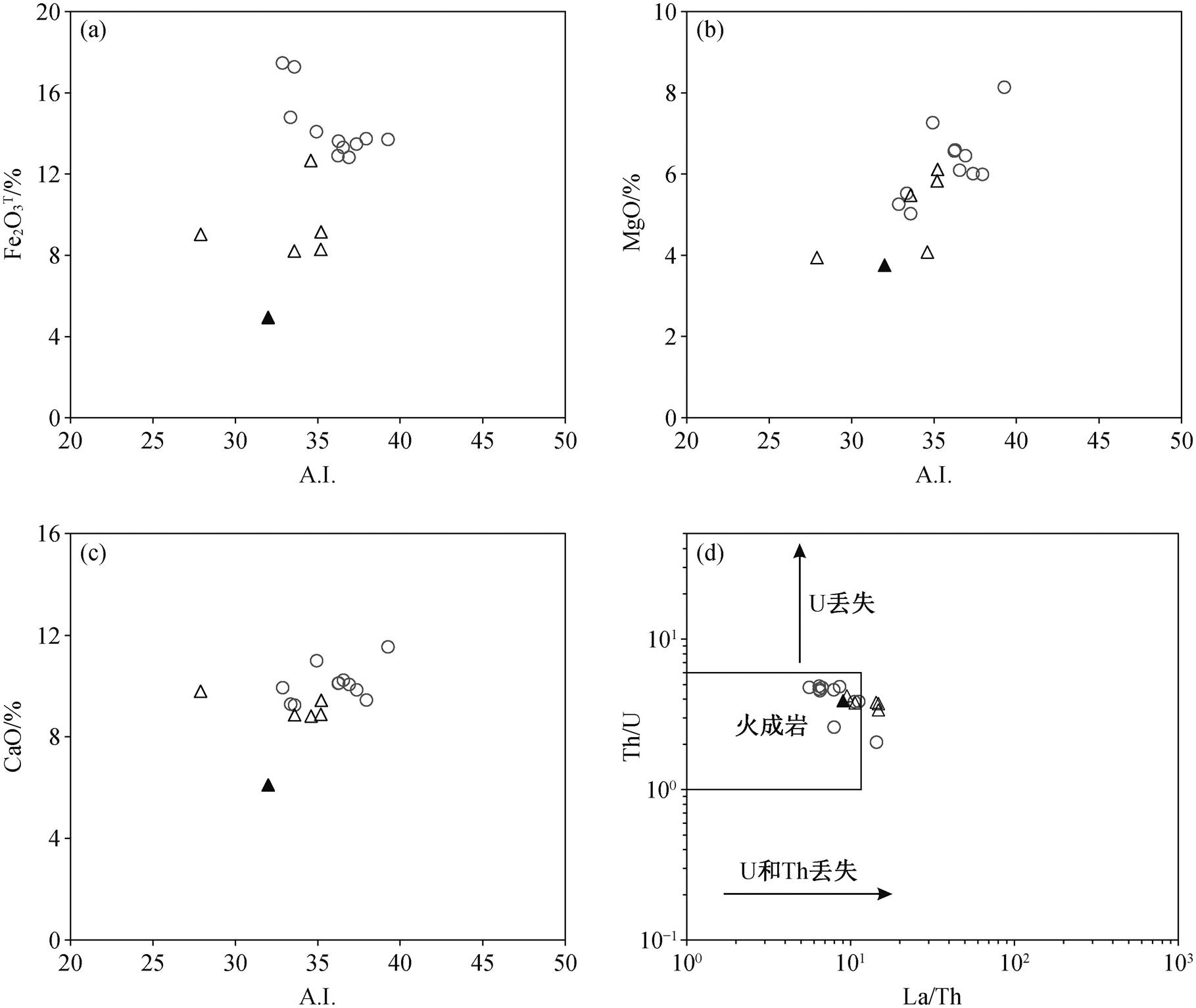
圆圈为玄武岩样品, 空心三角形为玄武安山岩样品, 实心三角形为样品16DX6-3, 下同。(d)的底图来自文献[84]
图3 恒山变质火山岩元素活动性判别图
Fig. 3 Selected element mobility diagrams for the metavolcanic rocks from Hengshan area
6 个变质玄武安山岩样品(附录 1)与上述变质玄武岩类似, 在 Zr/Y 对 Th/Yb 图解中主要落在过渡区域(图 4(b)), 而在 Co 对 Th 图解中位于钙碱性区域(图 4(c))。在 FeOT/MgO 对 SiO2 图解中, 大部分样
品位于钙碱性区域, 并且同样随岩浆演化无明显的富 Fe 趋势。与变质玄武岩样品相比, 这些变质玄武安山岩样品具有较高的 SiO2 (53.31%~62.67%)和Ni (56.69%~75.59 μg/g)含量以及Al2O3/TiO2 (19.40~ 28.95)、Nb/Y 以及 Zr/Ti 值, 较低的 MgO (3.75%~ 6.11%)、Fe2O3T (4.92%~12.68%)和 Co (15.82~35.19 μg/g)含量, Mg#值为 38.95~60.15。样品的 TREE 含量为 51.83~105.33μg/g。在球粒陨石标准化稀土元素分配模式图中, 该组变质玄武安山岩同样呈右倾的稀土元素分配样式, 但无明显的 Eu 异常(δEu= 0.89~1.04)(图 5(a2))。除样品 16DX6-3 具有较高的(La/Yb)N 值(16.72)和较低的 YbN 值(4.70)外, 其他样品具有较低的(La/Yb)N 值(2.99~4.56)和较高的 YbN值(10.58~13.69)。在 N-MORB 标准化蛛网图中, 样品富集 Th, La 和 Ce 元素, 亏损 Nb 和 Ti 等元素(图5(b2))。
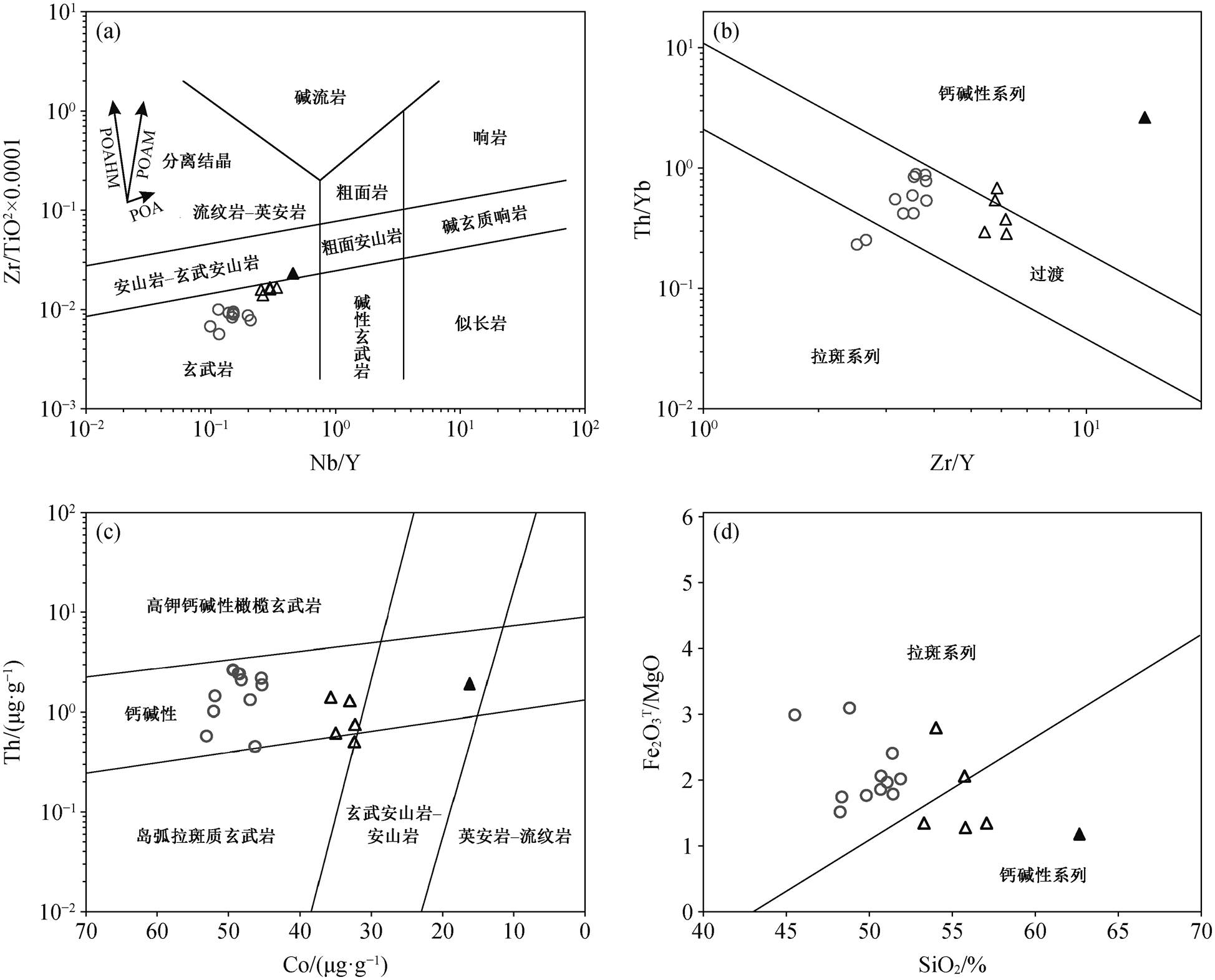
(a)火山岩分类图解, 底图来自文献[87], 其中矿物分离结晶趋势: POA=斜长石+橄榄石+普通辉石, POAM=斜长石+橄榄石+普通辉石+磁铁矿, POAHM=斜长石+橄榄石+普通辉石+角闪石+磁铁矿; (b)~(d)的底图分别来自文献[88]、[89]和[90]
图4 恒山火山岩地球化学分类图解
Fig. 4 Petrochemical classification diagrams for the metavolcanic rocks from Hengshan area
样品 16DX6-3 为包裹住样品 16DX6-1 的角闪斜长片麻岩, 其锆石自形程度较好, 多呈短柱至长柱状, 长约 50~200μm, 长宽比为 1:1~3:1。阴极发光图像显示, 绝大多数锆石发育同心震荡环带及较窄的亮白色增生边(图 6), Th/U 值介于 0.27~1.97 之间, 具有典型岩浆成因锆石特点。对该样品的 20颗锆石进行 20 个测点的分析, 获得的 207Pb/206Pb 表观年龄为 2439~2527Ma, 表明这些锆石形成于同一岩浆事件。20 个测点的数据构成一条不一致线, 其上交点年龄为 2508±12Ma (MSWD=0.35)。其中, 18个位于谐和线上测点的 207Pb/206Pb 加权平均年龄为2508±20Ma(MSWD=0.086), 与上交点年龄在误差范围内一致(图 7(a))。因此, 我们认为 207Pb/206Pb 加权平均年龄 2508±20Ma 可以代表恒山变质火山岩的原岩结晶年龄。此外, 选取 9 颗锆石进行原位Lu-Hf 同位素测试, 获得 176Lu/177Hf 值为 0.0006315~ 0.0009834, 176Hf/177Hf 值为 0.281337~0.281421, 对应的 εHf (2508Ma)值介于+3.9~+7.3 之间(图 7(b)), tDM1 为 2538~2670Ma, tDM2 为 2556~2768Ma。
恒山火山岩经历了强烈的变形和变质作用改造, 其形成时代一直存在争议。前人依据变质程度以及表壳岩的岩石组合等特征, 认为其形成时代可以与五台地区的五台群石咀亚群底部的金刚库组对 比[67,79]。五台群石咀亚群金刚库组的岩石组合主要由底部的超基性岩、下部的黑云变粒岩和斜长角闪岩夹磁铁石英岩以及上部的云母片岩、石英岩和钙硅质岩组成。Wang 等[91]在金刚库组斜长角闪岩中获得的年龄为 2543±4.1Ma; Han 等[31]在该组白峪里铁矿中的斜长片麻岩围岩里获得的年龄是 2543±25 Ma; 陈雪等[92]在该组黑云母石英片岩中的碎屑锆石里获得的 207Pb/206Pb 加权平均年龄为 2663±2Ma, 限定了金刚库组的最大沉积年龄。由此可见, 这些金刚库组的年龄数据在 2543~2663Ma 之间, 表明该组岩石的形成时代应早于 2520Ma。
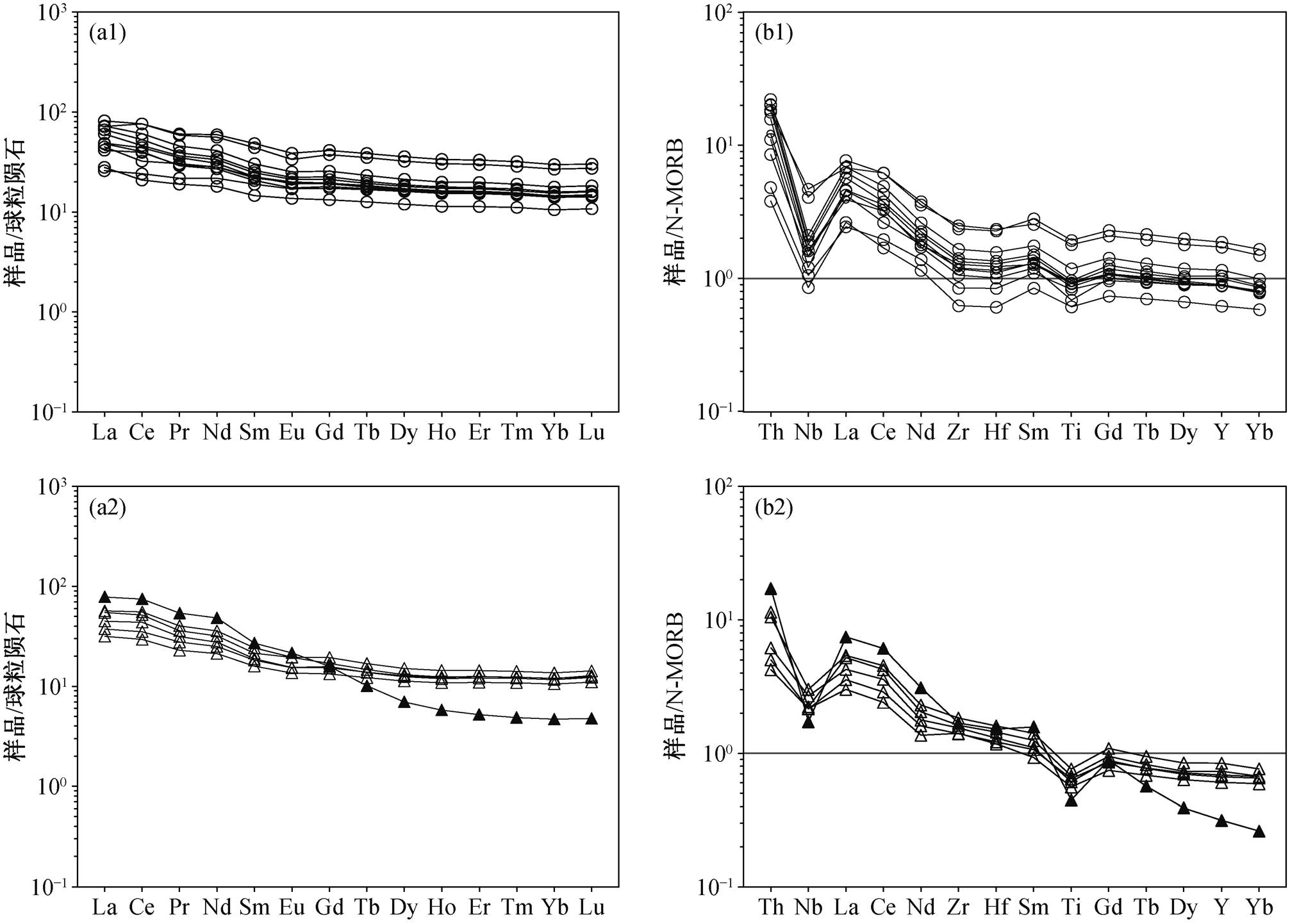
图5 恒山火山岩球粒陨石标准化稀土元素配分模式图((a1)和(a2))和N-MORB标准化多元素蛛网图((b1)和(b2))
Fig. 5 Chondrite-normalized REE ((a1) and (a2)) and N-MORB normalized ((b1) and (b2)) multi-element patterns for the metavolcanic rocks from Hengshan area
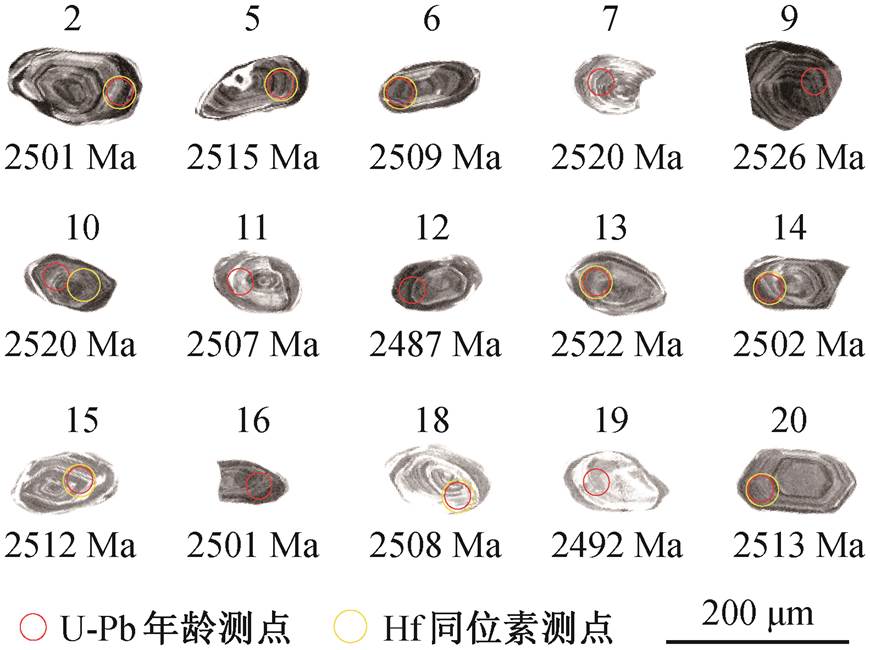
图6 代表性锆石阴极发光图像及 U-Pb-Hf 同位素测点位置
Fig. 6 CL images and corresponding U-Pb-Hf isotope analytical spots of the representative zircons
本次研究中, 我们在恒山地区变质火山岩中获得的年龄是 2508±20Ma, 明显晚于五台群金刚库组的形成时代。因此, 本文认为恒山火山岩不能归属五台金刚库组。野外地质证据表明, 恒山火山岩呈层状产出于表壳岩中, 或以包体(麻粒岩或斜长角闪岩)和顶垂体的形式残存在 TTG 片麻岩中, 表明其时代早于 TTG 片麻岩或与 TTG 片麻岩同期。前人在恒山地区雁门关和朱家坊地区表壳岩附近的TTG 片麻岩中获得的年龄为 2483~2526Ma[14,19,21,93], 本次研究获得的火山岩成岩年龄为 2508Ma, 与该区域广泛分布的 TTG 片麻岩形成时代近同期, 也与前人报道的恒山表壳岩中形成于 2501Ma 的杂砂岩时代接近[73]。因此, 我们认为恒山火山岩的形成时代晚于五台杂岩中五台群石咀亚群的金刚库组。结合前人对五台群中岩石的定年结果, 本文认为恒山火山岩的时代可以与五台群上部台怀亚群的鸿门岩组火山岩对比。可见, 恒山地区新太古代喷发的火山岩与几乎同期(约 2.52–2.48Ga)大量发育的花岗质岩石共同记录了恒山地区太古宙末期至古元古代早期的岩浆事件[14‒15,19,21]。
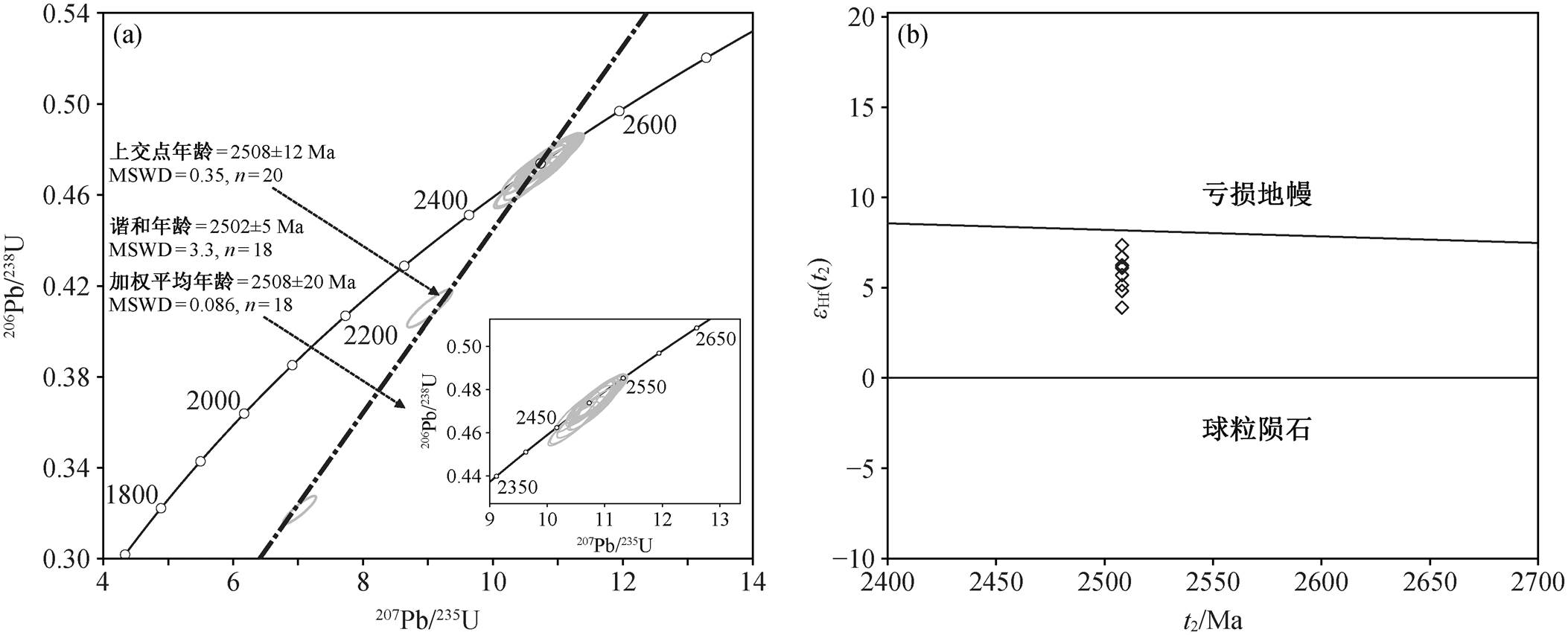
(b)的底图来自文献[21]
图7 样品16DX6-3的U-Pb谐和图(a)和锆石εHf(t2)对结晶年龄(t2)图解(b)
Fig. 7 Zircon U-Pb concordia diagram (a) and zircon εHf (t2) vs. crystallization age (t2) diagram (b) for sample 16DX6-3
五台‒恒山‒阜平地区在新太古代晚期到古元古代处于岛弧构造背景[13,17,20‒25,27‒28,32‒33,38,43‒45]。岛弧背景下形成的岩浆岩通常呈现分异的特点, 具有原始岩浆特点的岩浆岩很少出露[94]。恒山火山岩样品以具有较低的 Mg#值(36.54~60.15)、Ni (23.69~ 75.59μg/g)、Cr (56.45~189.81μg/g)和 MgO 含量为特征, 明显不同于原始岩浆(Mg#>64, Ni>200μg/g, Cr>400μg/g)[95]。在火山岩分类图(图 4(a))中, 这些样品也表现出演化的趋势, 进一步说明它们确实为岩浆分异的产物。
在哈克图解(图 8)中, 恒山火山岩样品的主量元素含量与 SiO2 含量之间呈现良好的相关性。随着 SiO2 含量增加, MgO, MnO, TiO2 和 Fe2O3 含量逐渐降低, 表现出结晶分异的特点, 单斜辉石、角闪石和磁铁矿等矿物为潜在的分离结晶矿物相。
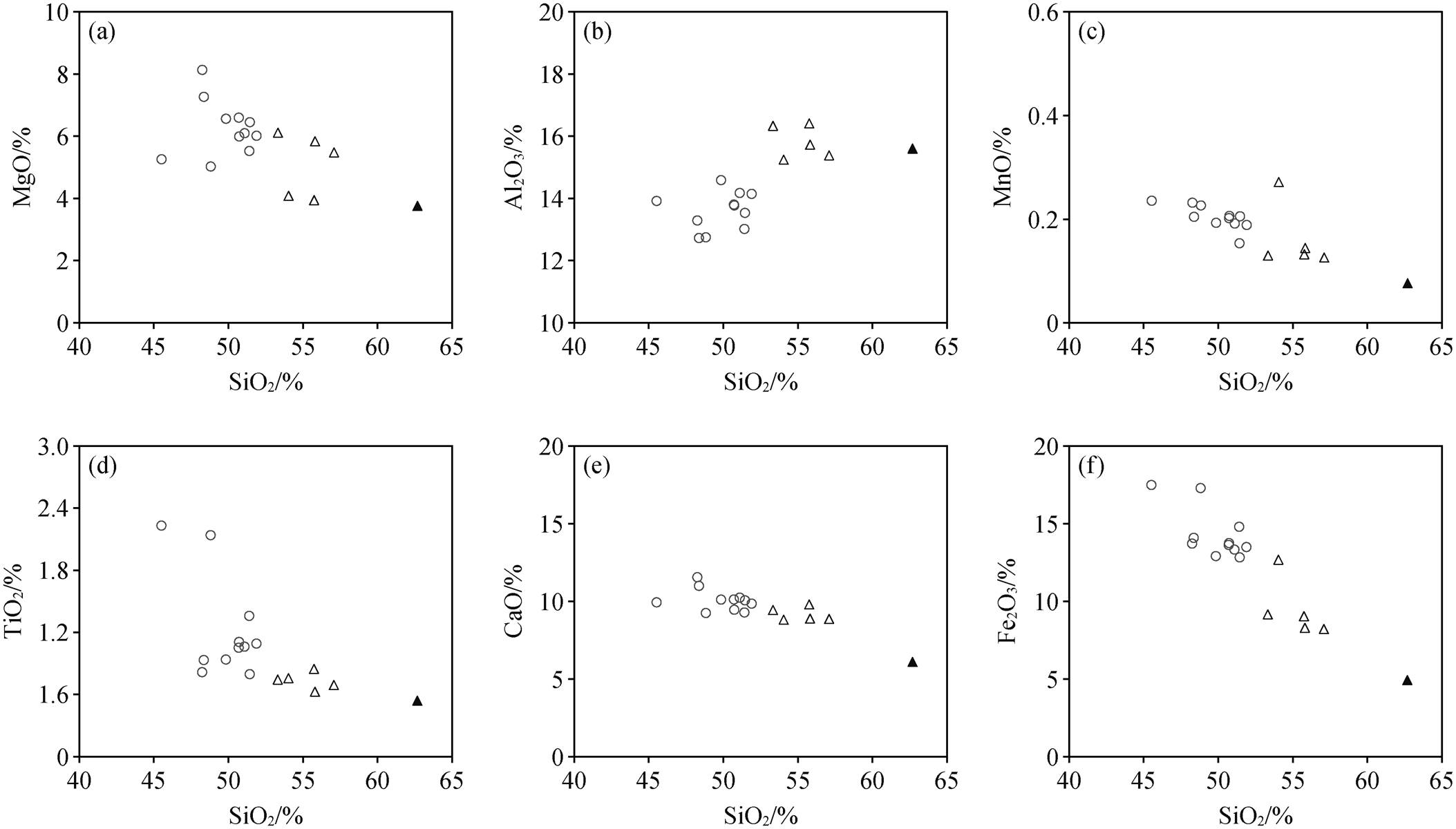
图8 恒山变质火山岩的哈克图解
Fig. 8 Harker diagrams of the Hengshan metavolcanic rocks
在图 9(a)和(b)中, 过渡族元素(Cr, Ni, V 和 Sc)之间呈现良好的相关性, 意味着单斜辉石发生分离结晶。研究表明, 中稀土元素在角闪石中的分配系数通常高于轻稀土和重稀土元素[99], 在其分离结晶的过程中会导致 La/Yb 值升高, Dy/Yb 值降低[98‒100], 因此稀土元素(REEs)是指示角闪石分离结晶的一项重要指标。如图 9(c)和(d)所示, 随着 SiO2 含量增加, 恒山玄武质岩石同样反映 La/Yb 值升高而 Dy/ Yb 值下降的趋势, 说明在其演化过程中发生了角闪石的分离结晶。从基性到中性, 这些火山岩样品的 Fe2O3 含量明显降低(图 8(f)), 表明可能存在磁铁矿的分离结晶。
在岩浆结晶过程中, 当分离结晶的矿物相以长石、橄榄石和辉石为主时, 熔体中的 Zr/Ti 值不会受到显著的影响; 当磁铁矿开始结晶后, 岩浆中的Ti 会逐渐亏损, 而 Zr 和 SiO2 却会继续增加[101]。本研究中的变质玄武岩具有较高的 Fe2O3 含量, 但是随着 SiO2 含量升高, Zr/Ti 值却没有发生明显的变化(图 9(e)), 说明在这个阶段, 磁铁矿并没有发生分离结晶。
变质玄武安山岩有着比变质玄武岩高的 Zr/Ti值, 且随着 SiO2 含量增加, Zr/Ti 值不断增加(图9(e)), 结合其 Fe2O3 含量明显降低的特征, 表明在该阶段出现磁铁矿的分离结晶。如前所述, 样品的Al2O3 含量与 SiO2 含量之间具有正相关的关系(图 8 (b)), 且所有样品均无明显的 Eu 负异常。此外, 除样品 16DX6-3 外, 其余样品的 Al2O3 含量随 SiO2 含量的增加, 且并未出现拐点, δEu 值也没有显著的变化, 表明在这些岩浆的演化过程中斜长石并没有发生明显的分离结晶。
通常, 岩浆在上升过程中会受到地壳物质的混染, 其 MgO 和 Cr, Ni, Co, V 等过渡族金属的元素含量会显著降低[102]。变质玄武岩样品的 SiO2 含量与MgO 含量和 Mg#之间没有明显的相关性(图 8(a)), 其 Co(45.35~52.00μg/g)和 V (255~449μg/g)含量明显高于大陆地壳(Co 含量为 26.6μg/g, V 含量为 138μg/g[102]), 说明地壳混染程度较低。在(Nb/La)N 对MgO 图解(图 10(a))中, 这些样品间呈现正相关性, 且在 Zr/Sm 对 Nb/Y 图解(图 10(b))中, 大部分样品没有地壳混染趋势, 进一步表明岩浆在上升过程中受地壳混染的影响较小。同样, 除 16DX6-3 外, 其他变质玄武安山岩样品的 SiO2 含量与 MgO 和 Mg#间未呈现明显的相关性(图 8(a)), (Nb/La)N 与 MgO之间也没有呈现明显的正相关性(图 10(a)), 且在Zr/Sm 对 Nb/Y 图解中样品也位于地壳混染趋势范围外(图 10(b)), 表明这些样品同样受地壳混染的影响较小。
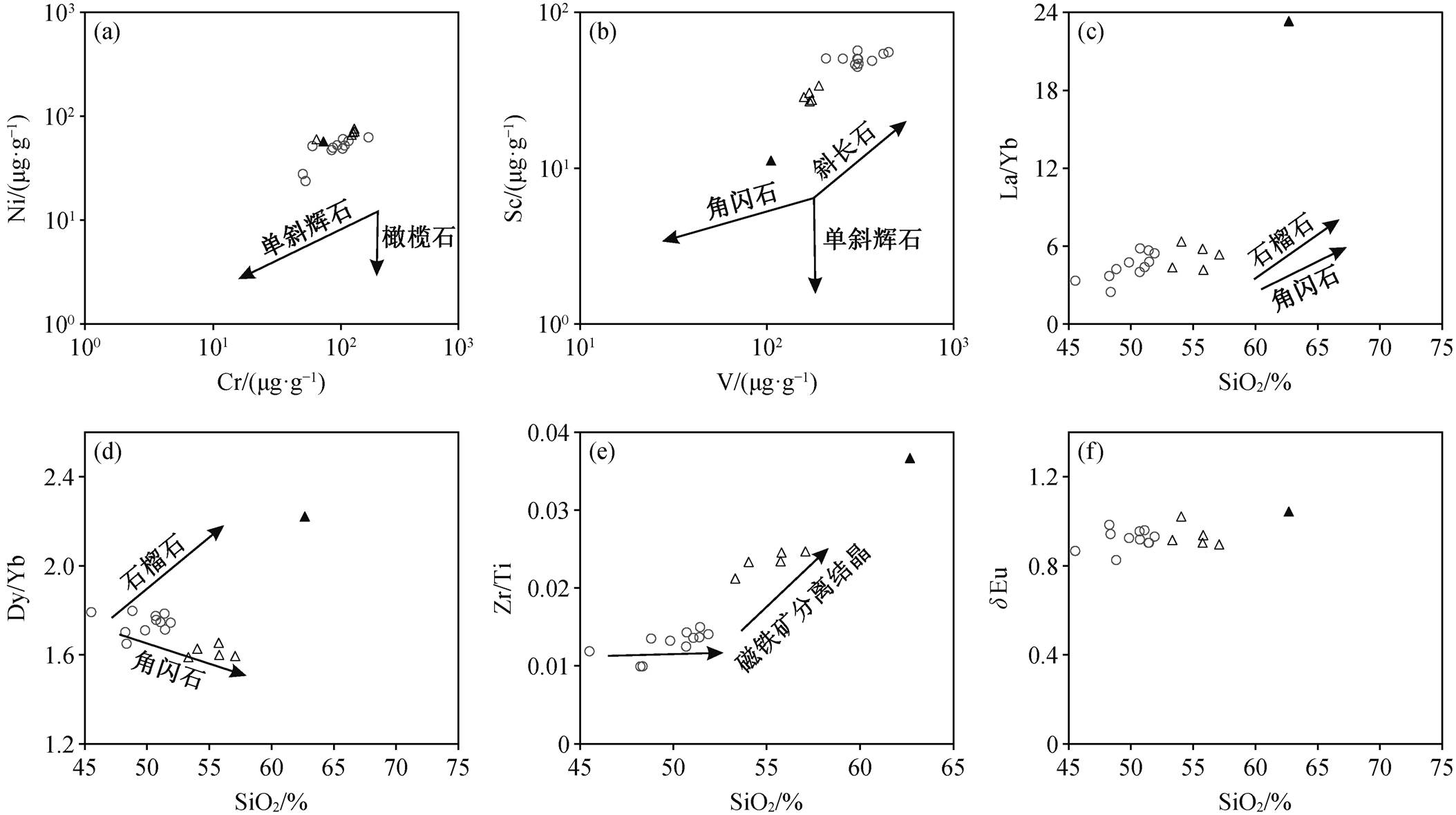
(a)、(b)和(e)的底图分别来自文献[96]、[97]和[87]; (c)和(d)为角闪石分离结晶判别图解, 底图来自文献[98]
图9 恒山变质火山岩矿物分离结晶鉴别图解
Fig. 9 Fractionation vectors modeled for crystallization of individual mineral phases from the Hengshan metavolcanic rocks
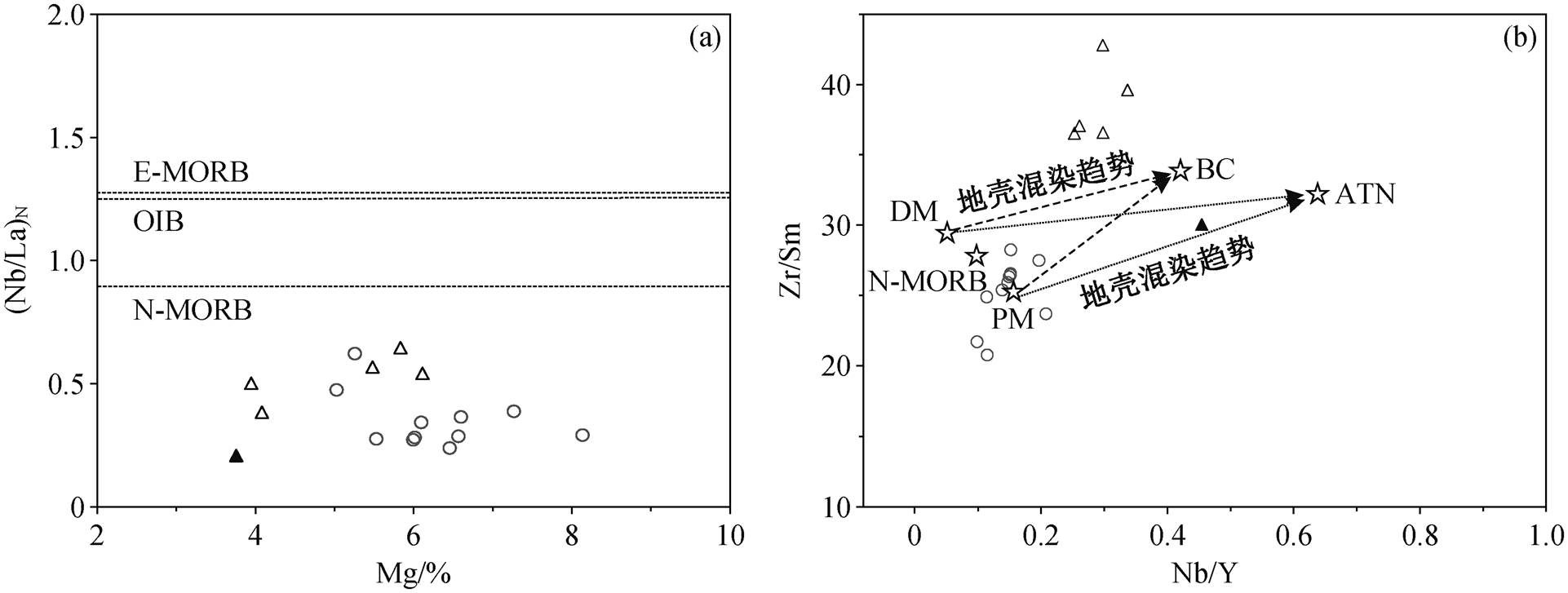
(a)的底图来自文献[103]; (b)中的点线表示地幔端元与华北克拉通平均 TTG 成分间的混合, 虚线代表地幔端元与大陆地壳成分间的混合, PM表示原始地幔[104], DM表示亏损地幔[105], BC表示大陆地壳[102], ATN表示华北克拉通平均TTG成分[106]
图10 恒山变质火山岩地球化学特征显示从玄武岩至玄武安山岩的成分变化不是地壳混染的结果
Fig. 10 Geochemical characteristics showing that the compositional variation of basaltic through andesitic volcanic rocks in the Hengshan metavolcanic samples is not the result of assimilation of continental crust
在所有火山岩样品中, 样品 16DX6-3 具有最低的(Nb/La)N 值和 MgO 含量, 其主微量元素特征与其他火山岩样品也明显不同, Co 和 V 等元素含量也明显低于其他样品。在 Zr/Sm 对 Nb/Y 图解(图 10(b))中, 样品 16DX6-3 也不同于其他样品, 落在地幔端元与华北克拉通平均 TTG 成分间的地壳混染趋势线附近。样品 16DX6-3 的这些特征及其变化范围较大的锆石 εHf (2508Ma)值(+3.9~+7.3)说明, 该样品来自亏损地幔源区, 但很可能在上升过程中受到地壳混染的影响。因此, 后续的成因讨论和构造属性研究中不再涉及该样品。
前人在研究太古宙变质火山岩时, 发现部分安山质岩石可能是早期镁铁质岩浆与长英质岩浆混合形成的[107], 表明中性火山岩形成过程中可能存在岩浆混合作用。但是, 本文恒山变质火山岩(包括变质玄武岩和变质玄武安山岩)样品具有相似的稀土元素分配特征(图 5(a1)和(a2)), 表明它们可能具有共同的岩浆源区。除样品 16DX6-3 外, 其他样品的(La/Yb)N值和 TREE 含量都相近, 在 Zr/Y 对Th/ Yb 图解(图 4(b))和 Co 对 Th 图解(图 4(c))中, 数据点几乎都落入相似的区域, 且变质玄武岩的 CaO含量未明显降低, 与变质玄武安山岩接近, 表明岩浆混合作用对恒山火山岩的成因影响有限。另外, 大部分主量元素与 SiO2 含量的关系展现较好的分离结晶趋势, 意味着样品间岩性的差异很可能主要受控于分离结晶作用。
本文的变质火山岩岩样品相对富集 LREE (图 5 (a1)和(a2)), 具有右倾的稀土元素分配特点, 并且富集 Th 而亏损 Nb 和 Ti (图 5(b1)和(b2)), 呈现火山弧岩浆的地球化学特征[108]。这种具有火山弧岩浆地球化学特征的火山岩不只产出于岛弧构造背景, 也可能出现在受到岩石圈混染的大陆裂谷和弧后盆地等拉张环境以及碰撞造山带环境的岩石当中[109]。本研究中, 除样品 16DX6-3 外, 其他样品受地壳混染的影响较小, 且其 Th/Nb 值均小于 1, 未表现出岩石圈地幔组分混染的特征。
N-MORB 标准化蛛网图可以很好地区分上述几种不同的构造环境, 原因是 N-MORB 代表一种无源区富集、熔融过程中无复杂残留体以及没有与大陆地壳相互作用的岩浆组分, 当样品与它进行比较时, 可以较直观地反映样品的富集或亏损地球化学特征及熔融特点[87]。产自受岩石圈混染的拉张体系和碰撞造山带环境的玄武质岩浆形成的深度通常较大, 为低程度部分熔融的产物, 具有比岛弧岩浆更高的高场强元素(HFSE)含量, 且 Zr 和 Ti 含量大于 N-MORB。岛弧岩浆形成深度一般较浅, 且受到板片流体或熔体的交代, 为高度部分熔融的产物, 高场强元素含量通常较低, 呈现低 Zr, Ti 含量和低Ti/Y比值的特点。
在 N-MORB 标准化蛛网图(图 5(a2)和(b2))中, 大部分样品表现出低 Ti 含量(低于 N-MORB)和低(Ti/Y)N-MORB 值的特征, 意味着这些变质火山岩很可能形成于岛弧构造环境。在 Nb/Yb 对 Th/Yb 图(图 11(a))中, 这些火山岩样品的 Th/Yb 值都迁移到MORB-OIB 阵列之上, 并呈垂直于且高于 MORB-OIB 的阵列分布, 进一步证明它们是形成于火山弧构造背景的火山岩。再者, 在 Nb/Yb 对 Zr/Yb 图解(图 11(b))中, 样品数据落入地幔演化线内, 且居于N-MORB 与 E-MORB 之间, 表明其来自富集地幔源。此外, 这些变质火山岩具有相近的(Hf/Sm)N 值, 但(Nb/La)N 值的变化却较大(图 11(c)), 表明这些变质火山岩的地幔源主要受到俯冲相关流体的交代。
不少学者认为五台‒恒山‒阜平地区新太古代‒古元古代为俯冲的岛弧环境[13,17,20‒25,27‒28,32‒33,38,43‒45],但对其究竟是形成于大陆弧环境[13‒15]还是大洋岛弧环境[17,20,28,33,45‒46], 仍然存在争议。
恒山新太古代‒古元古代早期的变质火山岩喷发于 2508Ma (<2.52Ga), 属于 Sun 等[21]所指五台‒恒山‒阜平地区新太古代‒古元古代早期岩浆演化的第二阶段。该阶段, 五台地区的火山岩主要发育于台怀亚群鸿门岩组地层中, 并以钙碱性玄武岩‒玄武安山岩为特点。这些火山岩的地球化学特征有别于该区大量分布的 2.52Ga 之前的石咀亚群具有岛弧拉斑玄武岩质特征的变质火山岩[13,24]。目前主要依据恒山和阜平地区变质火山岩的变质程度和表壳岩的岩石组合, 将其形成时代限定为太古宙晚期‒古元古代[67], 缺少相关地球化学资料。
对恒山和阜平地区 TTG 片麻岩的年代学研究结果表明它们都形成于 2.52Ga 之后[14]。然而, 五台地区不仅有 2.52Ga 之前的花岗质岩石, 而且存在大量 2.52Ga 之后的花岗质岩石[14‒15,31,114]。五台地区这些 2.52Ga 之前形成的花岗质岩石具有高 εHf (t2)(+4.7~+8.3)值, 表现出亏损的锆石 Hf 同位素特征, 显示其形成于洋弧环境[20,24,28,33]。相比而言, 五台‒恒山‒阜平地区 2.52Ga 之后的 TTG 片麻岩却表现出更富集锆石 Hf 同位素的特征(εHf (t2) = −1.8~ +7.5), 推断其受到地壳的影响, 表明该地区存在古老地壳[21]。前人的研究也揭示恒山和阜平地区都存在老地壳残留[115‒116]。本次研究的恒山火山岩形成于 2.52Ga 之后, 呈现钙碱性特征, 有别于洋弧背景下形成的火山岩[87,113], 表现出高的 Nb, Zr 含量和Zr/Y 比值特点。在 Zr 对 Zr/Y 图解(图 11(d))中, 绝大部分样品落入大陆弧火山岩区域, 呈现大陆弧火山岩的特征。因此, 我们推断喷发于 2508Ma 的恒山变质火山岩很可能形成于大陆弧环境。
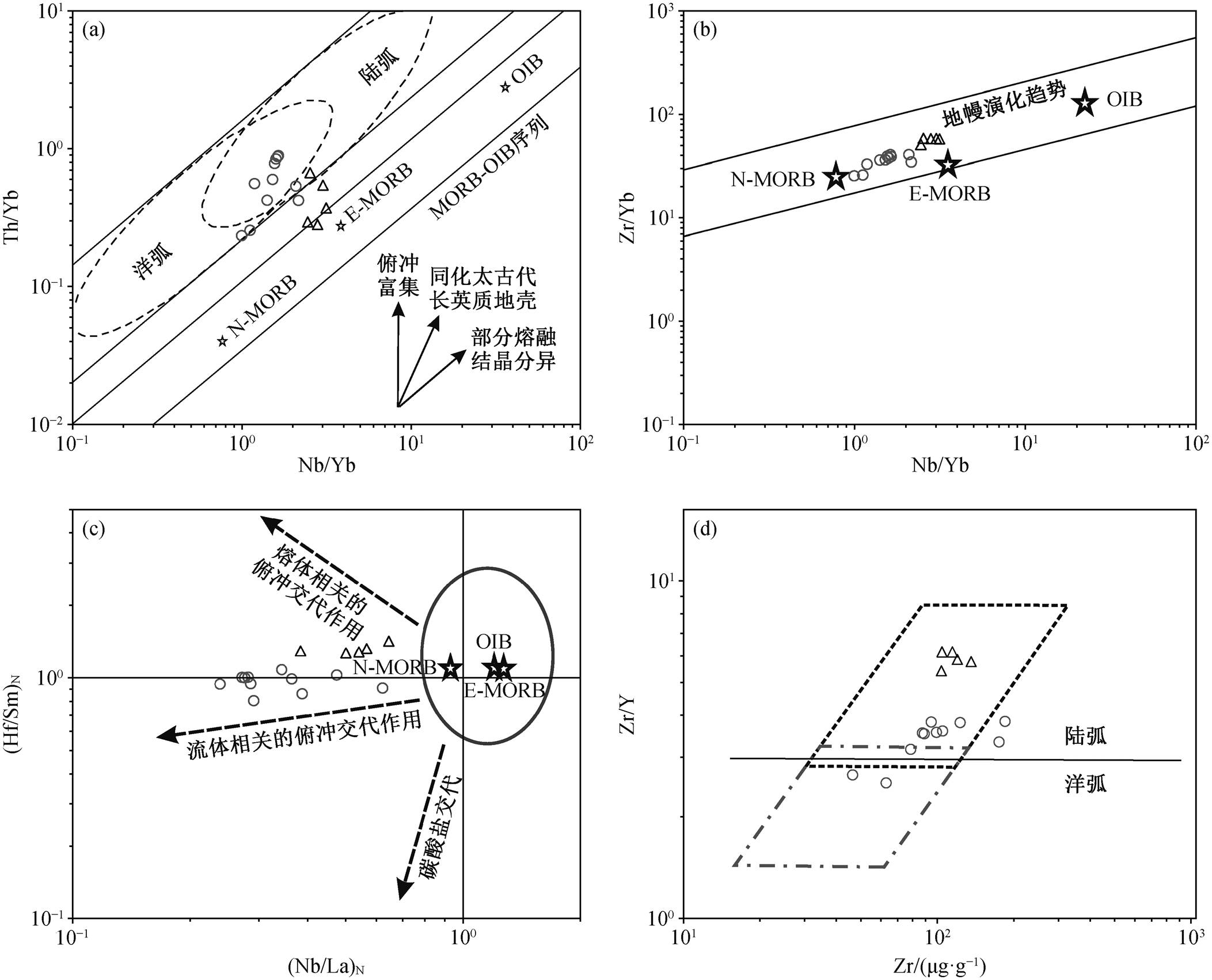
(a)~(d)的底图分别来自文献[110]、[111]、[112]和[113]
图11 恒山变质火山岩地球化学判别图
Fig. 11 Geochemical discrimination plots for the metavolcanic rocks from Hengshan area
通过对华北克拉通中部带恒山高级变质区中变质火山岩的岩石学、地球化学、锆石 U-Pb 年代学和 Lu-Hf 同位素研究, 结合前人的研究成果, 得到以下结论。
1)恒山变质火山岩的原岩形成时代为 2508Ma, 晚于五台杂岩中的石咀亚群金刚库组, 而与五台群台怀亚群鸿门岩组的形成时代相当。
2)恒山变质火山岩是大陆岛弧背景下, 主要受到俯冲板片流体交代的地幔楔部分熔融产生的同源岩浆, 在其上升演化过程中经历单斜辉石、角闪石和磁铁矿分离结晶作用的产物。
参考文献
[1]Bédard J H. How many arcs can dance on the head of a plume? A ‘Comment’ on: a critical assessment of Neoarchean ‘plume only’ geodynamics: evidence from the Superior province, by Derek Wyman. Pre-cambrian Research, 2013, 229: 189‒197
[2]Turner S, Rushmer T, Reagan M, et al. Heading down early on? Start of subduction on Earth. Geology, 2014, 42(2): 139‒142
[3]Zhai M G, Santosh M. The early Precambrian odyssey of the North China Craton: a synoptic overview. Gondwana Research, 2011, 20(1): 6‒25
[4]Zhai M G, Santosh M. Metallogeny of the North China Craton: link with secular changes in the evol-ving earth. Gondwana Research, 2013, 24(1): 275‒ 297
[5]Capitanio F A, Nebel O, Cawood P A, et al. Re-conciling thermal regimes and tectonics of the early earth. Geology, 2019, 47(10): 923‒927
[6]Capitanio F A, Nebel O, Cawood P A, et al. Lithos-phere differentiation in the early earth controls Ar-chean tectonics. Earth and Planetary Science Letters, 2019, 525: 115755
[7]Cawood P A, Hawkesworth C J, Pisarevsky S A, et al. Geological archive of the onset of plate tectonics. Philosophical Transactions of the Royal Society, 2018, A376: 20170405
[8]Hawkesworth C, Cawood P A, Dhuime B. Rates of generation and growth of the continental crust. Geo-science Frontiers, 2019, 10(1): 165‒173
[9]Korenaga J. Initiation and evolution of plate tectonics on earth: theories and observations. Annual Review of Earth and Planetary Sciences, 2013, 41: 117‒151
[10]刘树文, 包涵, 高磊, 等. 华北克拉通中东部新 太古代晚期变质火山岩及动力学体制. 岩石学报, 2021, 37(1): 113–128
[11]Keller C B, Schoene B. Statistical geochemistry reveals disruption in secular lithospheric evolution about 2.5 Gyr ago. Nature, 2012, 485: 490‒493
[12]Anhaeusser C R. Archaean greenstone belts and associated granitic rocks — a review. Journal of African Earth Sciences, 2014, 100: 684‒732
[13]Zhao G C, Kroener A, Wilde S A, et al. Lithotectonic elements and geological events in the Hengshan-Wutai-Fuping belt: a synthesis and implications for the evolution of the Trans-North China Orogen. Geo-logical Magazine, 2007, 144(5): 753‒775
[14]Kröner A, Wilde S A, Li J H, et al. Age and evolution of a late Archean to Paleoproterozoic upper to lower crustal section in the Wutaishan/Hengshan/Fuping terrain of northern China. Journal of Asian Earth Sciences, 2005, 24(5): 577‒595
[15]Kröner A, Wilde S A, O’Brien P J, et al. Field rela-tionships, geochemistry, zircon ages and evolution of a late Archaean to Palaeoproterozoic lower crustal section in the Hengshan Terrain of northern China. Acta Geologica Sinica (English Edition), 2005, 79(5): 605‒632
[16]Liu S W, Pan Y M, Li J H, et al. Geological and isotopic geochemical constraints on the evolution of the Fuping Complex, North China Craton. Precam-brian Research, 2002, 117(1/2): 41‒56
[17]Liu S W, Pan Y M, Xie Q L, et al. Archean geody-namics in the Central Zone, North China Craton: con-straints from geochemistry of two contrasting series of granitoids in the Fuping and Wutai complexes. Precambrian Research, 2004, 130: 229‒249
[18]王凯怡, 李继亮, 刘如琦. 阜平片麻岩之成因. 地质科学, 1991(3): 254‒267
[19]Hu Y L, Liu S W, Fu J H, et al. Neoarchean-early Paleoproterozoic granitoids, the geothermal gradient and geodynamic evolution in the Hengshan Terrane, North China Craton. Gondwana Research, 2021, 94: 143‒163
[20]Polat A, Kusky T, Li J H, et al. Geochemistry of Neoarchean (ca. 2.55‒2.50 Ga) volcanic and ophio-litic rocks in the Wutaishan greenstone belt, central orogenic belt, North China craton: implications for geodynamic setting and continental growth. Geologi-cal Society of America Bulletin, 2005, 117(11/12): 1387‒1399
[21]Sun D, Li Q G, Liu S W, et al. Neoarchean-Paleo-proterozoic magmatic arc evolution in the Wutai-Hengshan-Fuping area, North China Craton: new per-spectives from zircon U-Pb ages and Hf isotopic data. Precambrian Research, 2019, 331: 105368
[22]Trap P, Faure M, Lin W, et al. Contrasted tectonic styles for the Paleoproterozoic evolution of the North China Craton: evidence for a similar to 2.1 Ga ther-mal and tectonic event in the Fuping Massif. Journal of Structural Geology, 2008, 30(9): 1109‒1125
[23]Trap P, Faure M, Lin W, et al. Paleoproterozoic tec-tonic evolution of the Trans-North China Orogen: toward a comprehensive model. Precambrian Resear-ch, 2012, 222: 191‒211
[24]Wang Z H, Wilde S A, Wang K Y, et al. A MORB- arc basalt-adakite association in the 2.5 Ga Wutai greenstone belt: late Archean magmatism and crustal growth in the North China Craton. Precambrian Re-search, 2004, 131(3/4): 323‒343
[25]李继亮, 王凯怡. 五台山早元古代碰撞造山带初步认识. 地质科学, 1990(1): 1‒11
[26]王凯怡. 五台山地区原金刚库组中含蓝晶石组合的变质作用及其意义. 岩石学报, 1996, 12(1): 88‒98
[27]Gao P, Santosh M. Building the Wutai arc: Insights into the Archean — paleoproterozoic crustal evolu-tion of the North China Craton. Precambrian Research, 2019, 333: 105429
[28]Liu C H, Zhao G C, Liu F L, et al. Constraints of volcanic rocks of the Wutai Complex (Shanxi Pro-vince, Northern China) on a giant late Neoarchean intra-oceanic arc system in the Trans-North China Orogen. Journal of Asian Earth Sciences, 2016, 123: 178‒212
[29]Lu Y J, Liu S W, Zhao G C, et al. Geochemistry and petrogenesis of Neoarchean metamorphic mafic rocks in the Wutai Complex. Acta Geologica Sinica (Eng-lish Edition), 2006, 80(6): 899‒911
[30]Sun M, Armstrong R, Lambert, R S. Petrochemistry and Sr, Pb, and Nd isotopic geochemistry of early precambrian rocks, Wutaishan and Taihangshan areas, China. Precambrian Research, 1992, 56(1/2): 1‒31
[31]Han C M, Xiao W J, Su B X, et al. Neoarchean Algoma-type banded iron formation from the Nor-thern Shanxi, the Trans-North China Orogen: SIMS U-Pb age, origin and tectonic setting. Precambrian Research, 2017, 303: 548‒572
[32]Li Q G, Liu S W, Wang Z Q, et al. Contrasting provenance of Late Archean metasedimentary rocks from the Wutai Complex, North China Craton: detrital zircon U-Pb, whole-rock Sm-Nd isotopic, and geoche-mical data. International Journal of Earth Sciences, 2008, 97(3): 443‒458
[33]Liu C H, Liu F L, Shi J R, et al. Depositional age and provenance of the Wutai Group: evidence from zircon U-Pb and Lu-Hf isotopes and whole-rock geoche-mistry. Precambrian Research, 2016, 281: 269‒290
[34]He L C, Zhang J, Zhao G C, et al. Macro- and microstructural analysis of the Zhujiafang ductile shear zone, Hengshan Complex: tectonic nature and geodynamic implications of the evolution of Trans-North China Orogen. Geological Society of America Bulletin, 2021, 133(5/6): 1237‒1255
[35]Qian J H, Wei C J. P-T-t evolution of garnet am-phibolites in the Wutai-Hengshan area, North China Craton: insights from phase equilibria and geochrono-logy. Journal of Metamorphic Geology, 2016, 34(5): 423‒446
[36]Qian J H, Wei C J, Clarke G L, et al. Metamorphic evolution and Zircon ages of Garnet-orthoamphibole rocks in southern Hengshan, North China Craton: insights into the regional Paleoproterozoic P-T-t his-tory. Precambrian Research, 2015, 256: 223‒240
[37]Qian J H, Wei C J, Yin C Q. Paleoproterozoic P-T-t evolution in the Hengshan-Wutai-Fuping area, North China Craton: evidence from petrological and geo-chronological data. Precambrian Research, 2017, 303: 91‒104
[38]Trap P, Faure M, Lin W, et al. Late Paleoproterozoic (1900‒1800 Ma) nappe stacking and polyphase defor-mation in the Hengshan-Wutaishan area: implications for the understanding of the Trans-North-China belt, North China Craton. Precambrian Research, 2007, 156(1/2): 85‒106
[39]Wei C J, Qian J H, Zhou X W. Paleoproterozoic crus-tal evolution of the Hengshan-Wutai-Fuping region, North China Craton. Geoscience Frontiers, 2014, 5(4): 485‒497
[40]Zhang J, Zhao G C, Li S Z, et al. Deformation his-tory of the Hengshan Complex: implications for the tectonic evolution of the Trans-North China Orogen. Journal of Structural Geology, 2007, 29(6): 933‒949
[41]Zhang J, Zhao G C, Li S Z, et al. Polyphase defor-mation of the Fuping Complex, Trans-North China Orogen: structures, SHRIMP U-Pb zircon ages and tectonic implications. Journal of Structural Geology, 2009, 31(2): 177‒193
[42]魏春景. 华北中部造山带五台‒恒山地区古元古代变质作用与构造演化. 地球科学, 2018, 43(1): 24‒43
[43]Faure M, Trap P, Lin W, et al. Polyorogenic evolu-tion of the paleoproterozoic Trans-North China belt — new insights from the Luliangshan-Hengshan-Wutaishan and Fuping massifs. Episodes, 2007, 30(2): 96‒107
[44]Liu S W, Pan Y M, Xie Q L, et al. Geochemistry of the Paleoproterozonic Nanying granitic gneisses in the Fuping Complex: implications for the tectonic evolution of the Central Zone, North China Craton. Journal of Asian Earth Sciences, 2005, 24(5): 643‒ 658
[45]Wang Z H. Tectonic evolution of the Hengshan-Wutai-Fuping complexes and its implication for the Trans-North China Orogen. Precambrian Research, 2009, 170(1/2): 73‒87
[46]Wang K Y, Li J L, Hao J, et al. The Wutaishan orogenic belt within the Shanxi Province, northern China: a record of late Archaean collision tectonics. Precambrian Research, 1996, 78: 95‒103
[47]Zhao G C, Cawood P A, Wilde S A, et al. High-pressure granulites (retrograded eclogites) from the Hengshan Complex, North China Craton: petrology and tectonic implications. Journal of Petrology, 2001, 42(6): 1141‒1170
[48]Zhao G C, Zhai M G. Lithotectonic elements of Precambrian basement in the North China Craton: review and tectonic implications. Gondwana Research, 2013, 23(4): 1207‒1240
[49]Liu D Y , Nutman A P , Compston W , et al. Remnants of ≥3800 Ma crust in the Chinese part of the Sino-Korean Craton. Geology, 1992, 20(4): 339‒342
[50]Wan Y S, Liu D Y, Wang S J, et al. Similar to 2.7 Ga juvenile crust formation in the North China Craton (Taishan-Xintai area, western Shandong Province): further evidence of an understated event from U-Pb dating and Hf isotopic composition of zircon. Pre-cambrian Research, 2011, 186: 169‒180
[51]Zhai M G, Guo J H, Liu W J. Neoarchean to Paleo-proterozoic continental evolution and tectonic history of the North China Craton: a review. Journal of Asian Earth Sciences, 2005, 24(5): 547‒561
[52]Zhao G C, Sun M, Wilde S A, et al. Late Archean to Paleoproterozoic evolution of the North China Craton: key issues revisited. Precambrian Research, 2005, 136(2): 177‒202
[53]Zhao G C, Wilde S A, Cawood P A, et al. Thermal evolution of Archean basement rocks from the eastern part of the North China carton and its bearing on tectonic setting. International Geology Review, 1998, 40(8): 706‒721
[54]Diwu C R, Sun Y, Guo A L, et al. Crustal growth in the North China Craton at similar to 2.5 Ga: evidence from in situ zircon U-Pb ages, Hf isotopes and whole-rock geochemistry of the Dengfeng complex. Gond-wana Research, 2011, 20(1): 149‒170
[55]Geng Y S, Du L L, Ren L D. Growth and reworking of the early Precambrian continental crust in the North China Craton: constraints from zircon Hf isotopes. Gondwana Research, 2012, 21(2/3): 517‒529
[56]Guo J H, Sun M, Chen F K, et al. Sm-Nd and SHRIMP U-Pb zircon geochronology of high-pressure granulites in the Sanggan area, North China Craton: timing of Paleoproterozoic continental collision. Jour-nal of Asian Earth Sciences, 2005, 24(5): 629‒642
[57]Zhao G C, Cawood P A, Li S Z, et al. Amalgamation of the North China Craton: key issues and discussion. Precambrian Research, 2012, 222: 55‒76
[58]Zheng J P, Griffin W L, Ma Q, et al. Accretion and reworking beneath the North China Craton. Lithos, 2012, 149: 61‒78
[59]Kusky T, Li J, Santosh M. The Paleoproterozoic North Hebei orogen: North China craton’s collisional suture with the Columbia supercontinent. Gondwana Research, 2007, 12(1/2): 4‒28
[60]Santosh M, Liu S J, Tsunogae T, et al. Paleoprote-rozoic ultrahigh-temperature granulites in the North China Craton: implications for tectonic models on extreme crustal metamorphism. Precambrian Research, 2012, 222: 77‒106
[61]Trap P, Faure M, Lin W, et al. Syn-collisional chan-nel flow and exhumation of Paleoproterozoic high pressure rocks in the Trans-North China Orogen: the critical role of partial-melting and orogenic bending. Gondwana Research, 2011, 20(2/3): 498‒515
[62]Zhai M G, Bian A G, Zhao T P. The amalgamation of the supercontinent of North China Craton at the end of Neo-Archaean and its breakup during late Palaeo-proterozoic and Meso-Proterozoic. Science in China: Series D, 2000, 43(suppl 1): 219‒232
[63]Zhao G C, Wilde S A, Cawood P A, et al. Petrology and P-T path of the Fuping mafic granulites: impli-cations for tectonic evolution of the central zone of the North China craton. Journal of Metamorphic Geo-logy, 2000, 18(4): 375‒391
[64]翟明国. 华北克拉通的形成演化与成矿作用. 矿床地质, 2010, 29(1): 27‒39
[65]翟明国. 华北前寒武纪成矿系统与重大地质事件的联系. 岩石学报, 2013, 29(5): 1759‒1773
[66]Santosh M, Zhao D P, Kusky T. Mantle dynamics of the Paleoproterozoic North China Craton: a perspec-tive based on seismic tomography. Journal of Geo-dynamics, 2010, 49(1): 39‒53
[67]李江海. 恒山早前寒武纪地壳演化. 太原: 山西科学技术出版社, 1994
[68]刘树文, 李江海, 潘元明, 等. 太行山‒恒山太古代古老陆块: 年代学和地球化学制约. 自然科学进展, 2002, 12(8): 826‒833
[69]Kröner A, Wilde S A, Zhao G C, et al. Zircon geochronology and metamorphic evolution of mafic dykes in the Hengshan Complex of northern China: evidence for late Palaeoproterozoic extension and subsequent high-pressure metamorphism in the North China Craton. Precambrian Research, 2006. 146(1/2): 45‒67
[70]王仁民, 陈珍珍. 恒山灰色片麻岩和高压麻粒岩包体及其地质意义. 岩石学报, 1991(4): 36‒46
[71]张颖慧, 魏春景, 田伟, 等. 华北克拉通中部带恒山杂岩变质年龄的重新认识. 科学通报, 2013, 58 (34): 121‒128
[72]Liu S W, Li J H, Pan Y M, et al. An Archean continental block in the Taihangshan and Hengshan regions: constraints from geochronology and geoche-mistry. Progress in Natural Science-Materials Inter-national, 2002, 12(8): 568‒576
[73]王凯怡, 郝杰, Simon Wilde, 等. 山西五台山‒恒山地区晚太古‒早元古代若干关键地质问题的再认识: 单颗粒锆石离子探针质谱年龄提出的地质制约. 地质科学, 2000, 35(2): 175‒184
[74]庞尔成, 徐永婧, 施光海, 等. 山西代县金红石矿床洪塘矿区含矿岩石的地球化学及年代学. 岩石矿物学杂志, 2010, 29(5): 497‒506
[75]郭敬辉, 翟明国, 李永刚, 等. 恒山西段石榴石角闪岩和麻粒岩的变质作用、PT轨迹及构造意义. 地质科学, 1999, 34(3): 311‒325
[76]O'Brien P J, Walte N, Li J H. The petrology of two distinct granulite types in the Hengshan Mts, China, and tectonic implications. Journal of Asian Earth Sciences, 2005, 24(5): 615‒627
[77]Peng P, Guo J H, Zhai M G, et al. Genesis of the Hengling magmatic belt in the North China Craton: implications for Paleoproterozoic tectonics. Lithos, 2012, 148: 27‒44
[78]Wang Z H, Wilde S A, Wan J L. Tectonic setting and significance of 2.3‒2.1 Ga magmatic events in the Trans-North China Orogen: new constraints from the Yanmenguan mafic-ultramafic intrusion in the Hengshan-Wutai-Fuping area. Precambrian Research, 2010, 178: 27‒42
[79]吉成林, 赖兴运, 王仁民. 恒山东段古元古代表壳岩层序的特征和成因. 中国地质科学院地质研究所文集, 1993, 25: 85‒101
[80]Andersen T. Correction of common lead in U-Pb analyses that do not report Pb-204. Chemical Geo-logy, 2002, 192(1/2): 59‒79
[81]Rosing M T, Rose N M. The role of ultramafic rocks in regulating the concentrations of volatile and non-volatile components during deep crustal metamor-phism. Chemical Geology, 1993, 108: 187‒200
[82]Polat A, Hofmann A W. Alteration and geochemical patterns in the 3.7‒3.8 Ga Isua greenstone belt, West Greenland. Precambrian Research, 2003, 126(3/4): 197‒218
[83]Lafleche M R, Dupuy C, Bougault H. Geochemistry and petrogenesis of Archean mafic volcanic rocks of the southern Abitibi Belt, Québec. Precambrian Re-search, 1992, 57(3/4): 207‒241
[84]Blein O, LaFleche M R, Corriveau L. Geochemistry of the granulitic Bondy gneiss complex: a 1.4 Ga arc in the Central Metasedimentary Belt, Grenville Province, Canada. Precambrian Research, 2003, 120 (3/4): 193‒217
[85]Hart S R, Reid M R. Rb/Cs fractionation: a link between granulite metamorphism and the S-process. Geochimica Et Cosmochimica Acta, 1991, 55(8): 2379‒2383
[86]Guice G, McDonald I, Hughes H, et al. Assessing the validity of negative high field strength-element ano-malies as a proxy for Archaean subduction: evidence from the Ben Strome Complex, NW Scotland. Geo-sciences, 2018, 8(9): 338‒369
[87]Pearce J A. A User’s guide to basalt discrimination diagrams // Wyman D A. Trace element geochemistry of volcanic rocks: applications for massive sulphide exploration. Winnipeg: Geological Association of Ca-nada, Short Course Notes, 1996: 79‒113
[88]Ross P S, Bedard J H. Magmatic affinity of modern and ancient subalkaline volcanic rocks determined from trace-element discriminant diagrams. Canadian Journal of Earth Sciences, 2009. 46(11): 823‒839
[89]Hastie A R, Kerr A C, Pearce J A, et al. Classification of altered volcanic island arc rocks using immobile trace elements: development of the Th-Co discrimi-nation diagram. Journal of Petrology, 2007, 48(12): 2341‒2357
[90]Miyashiro A. Volcanic rock series in island arcs and active continental margines. American Journal of Science, 1974, 274(4): 321‒355
[91]Wang C L, Zhang L C, Lan C Y, et al. Petrology and geochemistry of the Wangjiazhuang banded iron formation and associated supracrustal rocks from the Wutai greenstone belt in the North China Craton: implications for their origin and tectonic setting. Precambrian Research, 2014, 255: 603‒626
[92]陈雪, 陈岳龙, 李大鹏, 等. 华北克拉通五台群LA-ICP-MS 锆石 U-Pb 年龄和 Hf 同位素特征. 地质通报, 2015, 34(5): 861‒876
[93]田永清, 梁英芳, 范嗣昆, 等. 恒山杂岩的年代学和钕同位素演化. 地球化学, 1992(3): 255‒264
[94]Leat P T, Riley T R, Wareham C D, et al. Tectonic setting of primitive magmas in volcanic arcs: an example from the Antarctic Peninsula. Journal of the Geological Society, 2002, 159: 31‒44
[95]Tatsumi Y, Eggins S. Subduction zone magmatism. Cambridge: Blackwell Science, 1995
[96]Gill J M. Orogenic andesites and plate tectonics. Berlin: Springer-Verlag, 1981
[97]Fu J H, Liu S W, Chen X, et al. Petrogenesis of taxitic dioritic-tonalitic gneisses and Neoarchean crustal growth in Eastern Hebei, North China Craton. Pre-cambrian Research, 2016, 284: 64‒87
[98]Davidson J, Turner S, Handley H, et al. Amphibole “sponge” in arc crust?. Geology, 2007, 35(9): 787‒ 790
[99]Bachmann O, Dungan M A, Bussy F. Insights into shallow magmatic processes in large silicic magma bodies: the trace element record in the Fish Canyon magma body, Colorado. Contributions to Mineralogy and Petrology, 2005, 149(3): 338‒349
[100]Macpherson C G, Dreher S T, Thirlwall M F. Adakites without slab melting: high pressure differentiation of island arc magma, Mindanao, the Philippines. Earth and Planetary Science Letters, 2006, 243(3/4): 581‒ 593
[101]Pearce J A, Norry M J. Petrogenetic implications of Ti, Zr, Y, and Nb variations in volcanic rocks. Con-tributions to Mineralogy and Petrology, 1979, 69(1): 33‒47
[102]Rudnick R, Gao S. The role of lower crustal recycling in continent formation. Geochimica et Cosmochimica Acta, 2003, 67(18): A403‒A403
[103]Wang W, Liu S, Santosh M, et al. Neoarchean intra-oceanic arc system in the Western Liaoning Province: implications for Early Precambrian crustal evolution in the Eastern Block of the North China Craton. Earth-Science Reviews, 2015, 150: 329‒364
[104]Sun S S, McDonough W F. Chemical and isotopic systematics of oceanic basalts: implications for man-tle composition and processes // Saunders A D, Norry M J. Magmatism in ocean basins. London: Geological Society London Special Publications, 1989: 313‒345
[105]Salters V J M, Stracke A. Composition of the depleted mantle. Geochemistry Geophysics Geosystems, 2004, 5: 217‒236
[106]Liou P, Shan H X, Liu F, et al. Petrogenesis of Neoarchean metavolcanic rocks in Changyukou, Northwestern Hebei: implications for the transition stage from a compressional to an extensional regime for the North China Craton. Lithos, 2017, 274: 53‒72
[107]He X, Wang W, Santosh M, et al. Late Neoarchean crustal growth under paired continental arc-back arc system in the North China Craton. Geoscience Fron-tiers, 2021, 12(3): 101120
[108]徐义刚, 王强, 唐功建, 等. 弧玄武岩的成因: 进展与问题. 中国科学: 地球科学, 2020, 50(12): 1818‒1844
[109]夏林圻, 夏祖春, 徐学义, 等. 利用地球化学方法判别大陆玄武岩和岛弧玄武岩. 岩石矿物学杂志, 2007, 26(1): 77‒89
[110]Smithies R H, Ivanic T J, Lowrey J R, et al. Two distinct origins for Archean greenstone belts. Earth and Planetary Science Letters, 2018, 487: 106‒116
[111]Pearce J A. Geochemical fingerprinting of oceanic basalts with applications to ophiolite classification and the search for Archean oceanic crust. Lithos, 2008, 100: 14‒48
[112]La Fleche M R, Camire G, Jenner G A. Geochemistry of post-Acadian, Carboniferous continental intraplate basalts from the Maritimes basin, Magdalen islands, Quebec, Canada. Chemical Geology, 1998, 148(3/4): 115‒136
[113]Pearce J A. Role of the sub-continental lithosphere in magma genesis at active continental margins. Con-tinental Basalts and Mantle Xenoliths, 1983, 4: 230‒ 249
[114]Zhao G C, Wilde S A, Cawood P A, et al. SHRIMP U-Pb zircon ages of the Fuping Complex: implica-tions for late Archean to Paleoproterozoic accretion and assembly of the North China Craton. American Journal of Science, 2002, 302(3): 191‒226
[115]Han B F, Xu Z, Ren R, et al. Crustal growth and intracrustal recycling in the middle segment of the Trans-North China Orogen, North China Craton: a case study of the Fuping Complex. Geological Ma-gazine, 2012, 149(4): 729‒742
[116]Wan Y S, Xie S W, Yang C H, et al. Early Neoarchean (~2.7 Ga) tectono-thermal events in the North Chi- na Craton: a synthesis. Precambrian Research, 2014, 247: 45‒63
Geochemical Features and Tectonic Significance of Late Archean Metavolcanic Rocks in Hengshan Area, North China Craton
Abstract Petrographic, geochemical, zircon U-Pb geochronogical and Hf isotopic data are presented for the exposed metavolcanic rocks in Hengshan region to determine their eruption age, petrogenesis and geodynamic significance in the Trans-North China Orogen, North China Craton. Zircon U-Pb dating of the rocks yielded a weighted mean 207Pb/206Pb age of 2508 ± 20 Ma, indicating that their protoliths were erupted in the late Neoarchean. Geochemically, the Hengshan metavolcanic rocks are composed of basalt and basaltic andesite and marked by variable SiO2 (45.51%–62.67%), FeOt (4.43%–15.72%) and MgO (3.75%–8.14%) contents, indicative of product of derivation from a mantle source with subsequent fractional crystallization of clinopyroxene, hornblende and magnetite. These metavolcanic rocks are characterized by enrichments in light rare earth elements (LREE) and large-ion lithophile elements (LILE), as well as depletions in heavy rare earth elements (HREE) and high-field-strength elements (HFSE), with relatively high Th content and Th/Yb values, similar to those of the typical calc-alkaline arc-like volcanic rocks. Such arc-like geochemical signatures, together with some incompatible elemental ratios (e.g., Nb/Yb, Zr/Yb and (Nb/La)N), reveal their origination from a sub-arc enriched mantle wedge variably metasomatized by the slab-derived dehydration fluids. Combined with the region geological background, these Hengshan metavolcanic rocks were developed on a continental arc setting in the late Neoarchean.
Key words Hengshan region; Late Neoarchean; metavolcanic rocks; geochemistry; continental arc